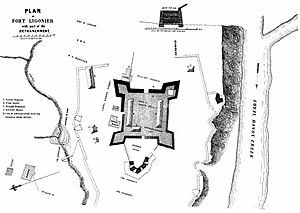Battle of Fort Ligonier facts for kids
Quick facts for kids Battle of Fort Ligonier |
|||||||
|---|---|---|---|---|---|---|---|
| Part of the French and Indian War | |||||||
 Plan of Fort Ligonier from an 1896 publication |
|||||||
|
|||||||
| Belligerents | |||||||
| Commanders and leaders | |||||||
| Captain Charles Philippe Aubry | Colonel James Burd | ||||||
| Strength | |||||||
| 440 troupes de la marine and militia 150 natives |
over 2,000 regulars and militia | ||||||
| Casualties and losses | |||||||
| Light | 12 killed 18 wounded 31 missing |
||||||
The Battle of Fort Ligonier was an important fight during the French and Indian War. It happened on October 12, 1758. French soldiers and their Native American allies attacked a British fort called Fort Ligonier. This fort was still being built! The British forces successfully defended their new fort, pushing back the attackers.
Contents
Why the Battle Happened
The French and Indian War was a big conflict. Britain wanted to take control of Fort Duquesne from the French. This fort was a key spot. From there, French and Native American groups often raided British settlements.
In 1758, the British tried again to capture Fort Duquesne. General John Forbes led this new effort. His army slowly built a road through the Allegheny Mountains. By early September, they reached a safe place called Loyal Hannon.
Here, Forbes's advance team started building Fort Ligonier. This fort was meant to be a winter camp. But French and Native American groups from Fort Duquesne kept attacking them.
A Risky Plan
To stop these attacks, General Forbes sent out a group of 750 men. They were led by James Grant. Their job was to scout out Fort Duquesne. But Grant tried to capture the fort instead!
He didn't realize how many French soldiers were there. This led to a big defeat for the British. Grant was captured, and many of his men were killed or hurt.
The French commander, François-Marie Le Marchand de Lignery, was running low on supplies. The British had also cut off his supply route. So, he decided to attack Fort Ligonier. He hoped to weaken the British and grab some of their supplies. He sent almost his entire force: 440 French soldiers and 150 Delaware Native Americans. Captain Charles Phillip Aubry led this attack.
The Battle at Fort Ligonier
Colonel James Burd was in charge of Fort Ligonier at the time. He had soldiers outside the fort. Some guarded supplies, and others watched the army's animals. These guards were spread out far from the fort.
The French and Native American attackers hit these guards first. When the fort heard the gunshots, Colonel Burd sent out about 200 soldiers. But the larger French force quickly pushed them back.
Soon, all 2,000 British soldiers in the fort were ready to fight. Colonel Burd sent out more troops to help. But the French and Native Americans kept pushing forward. All the British soldiers had to retreat inside the fort's defenses.
Fighting Continues
The British had powerful cannons. These cannons forced the French and Native Americans to pull back. They waited until it was dark to attack again.
Around 9:00 pm, they tried to storm one of the fort's strong points. But the British cannons fired again, driving them away. The French and Native Americans stayed near the fort all night. They sniped at guards and tried to find weak spots. They also killed or took about 200 horses. Then, they went back to Fort Duquesne.
James Smith, a frontiersman, later shared what the Native Americans said about the battle: "They said that Forbes's men were starting to learn how to fight. There were many American riflemen with the British soldiers. These riflemen hid behind trees and were very good shots. So, the attackers couldn't win and had to retreat."
What Happened Next
The attackers had very few casualties. The French reported only two killed and seven wounded. The British had more losses: 12 killed, 18 wounded, and 31 missing.
Colonel Bouquet was not happy with how his troops fought. He felt they showed too much "contempt" for the enemy.
The British kept working on Fort Ligonier. General Forbes arrived on November 2. Then, the British army marched toward Fort Duquesne with a large force. On November 24, the French commander, Lignery, destroyed Fort Duquesne. He sent his soldiers to other forts.
Fort Ligonier was used for a few more years, even during Pontiac's Rebellion. After that, it was left empty. Today, the fort has been rebuilt. It is now a historic site listed on the National Register of Historic Places.
See also
 In Spanish: Batalla de Fort Ligonier para niños
In Spanish: Batalla de Fort Ligonier para niños

